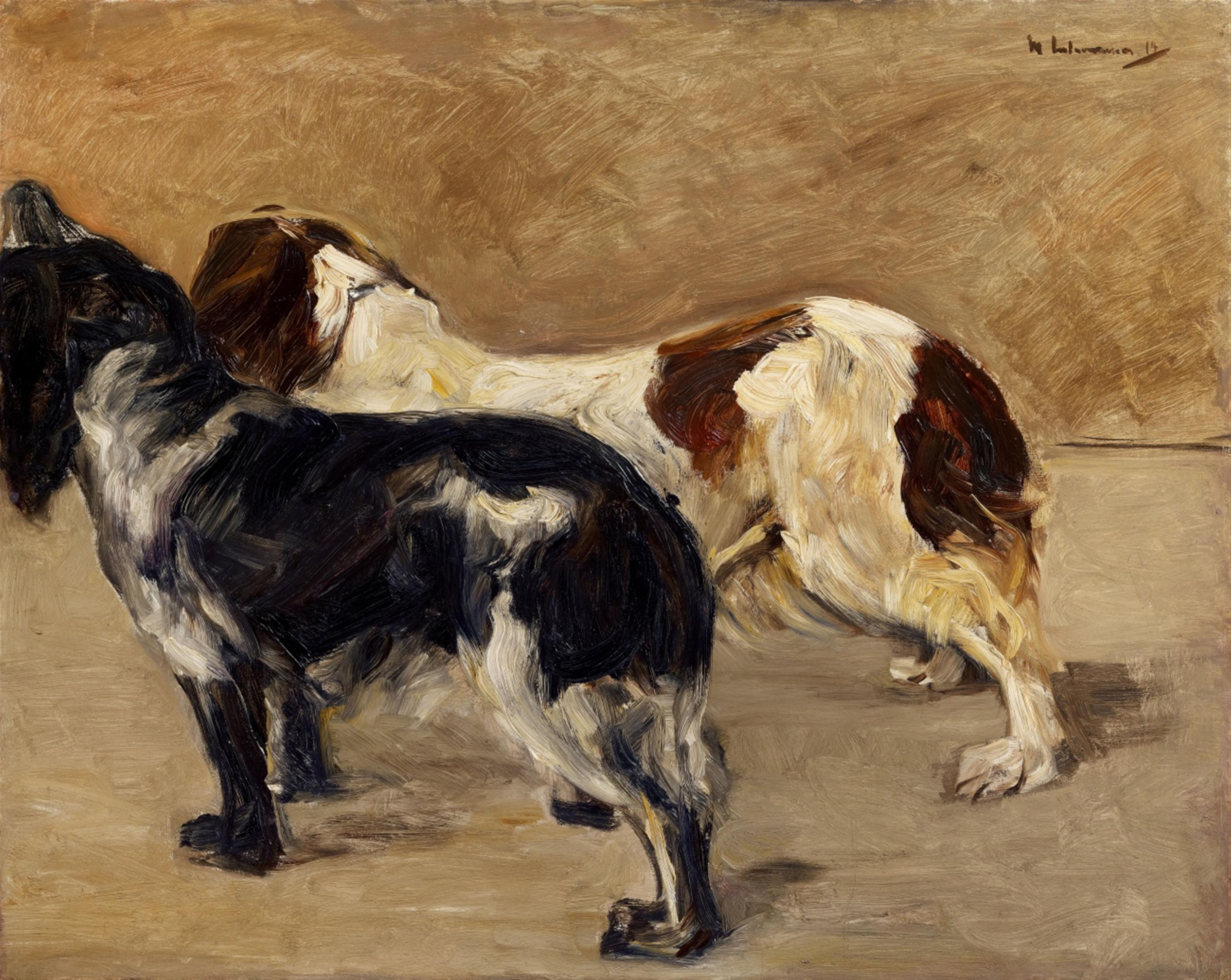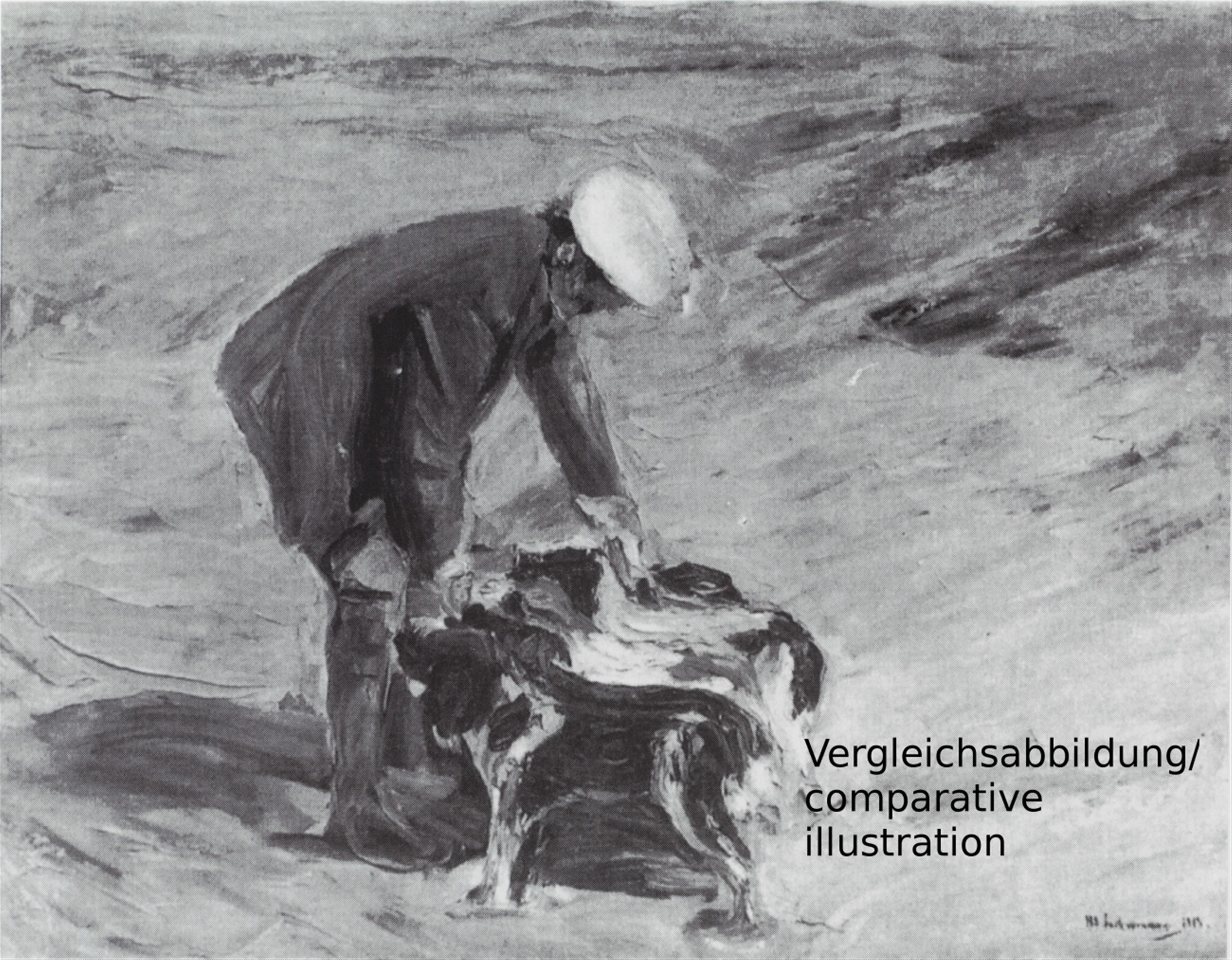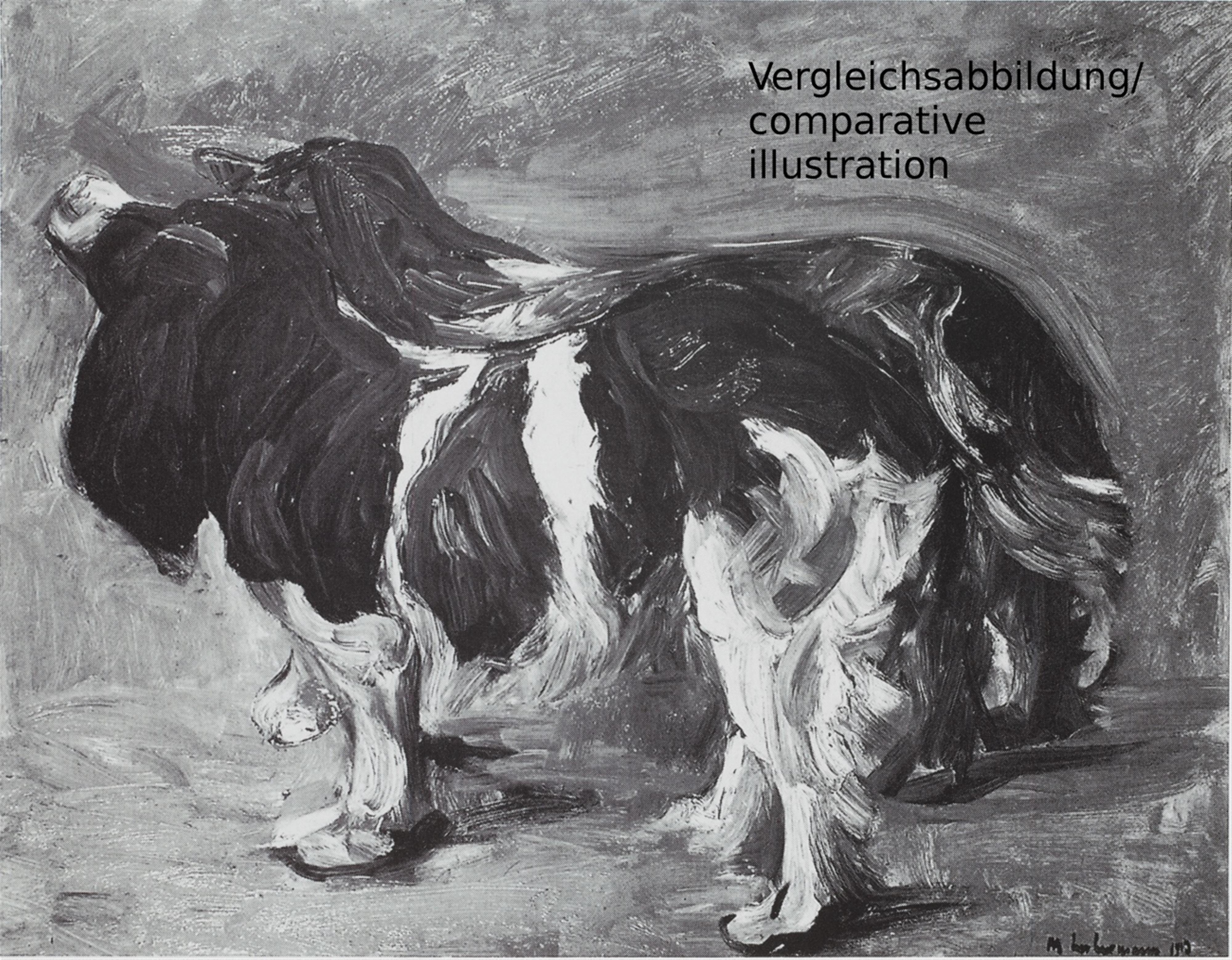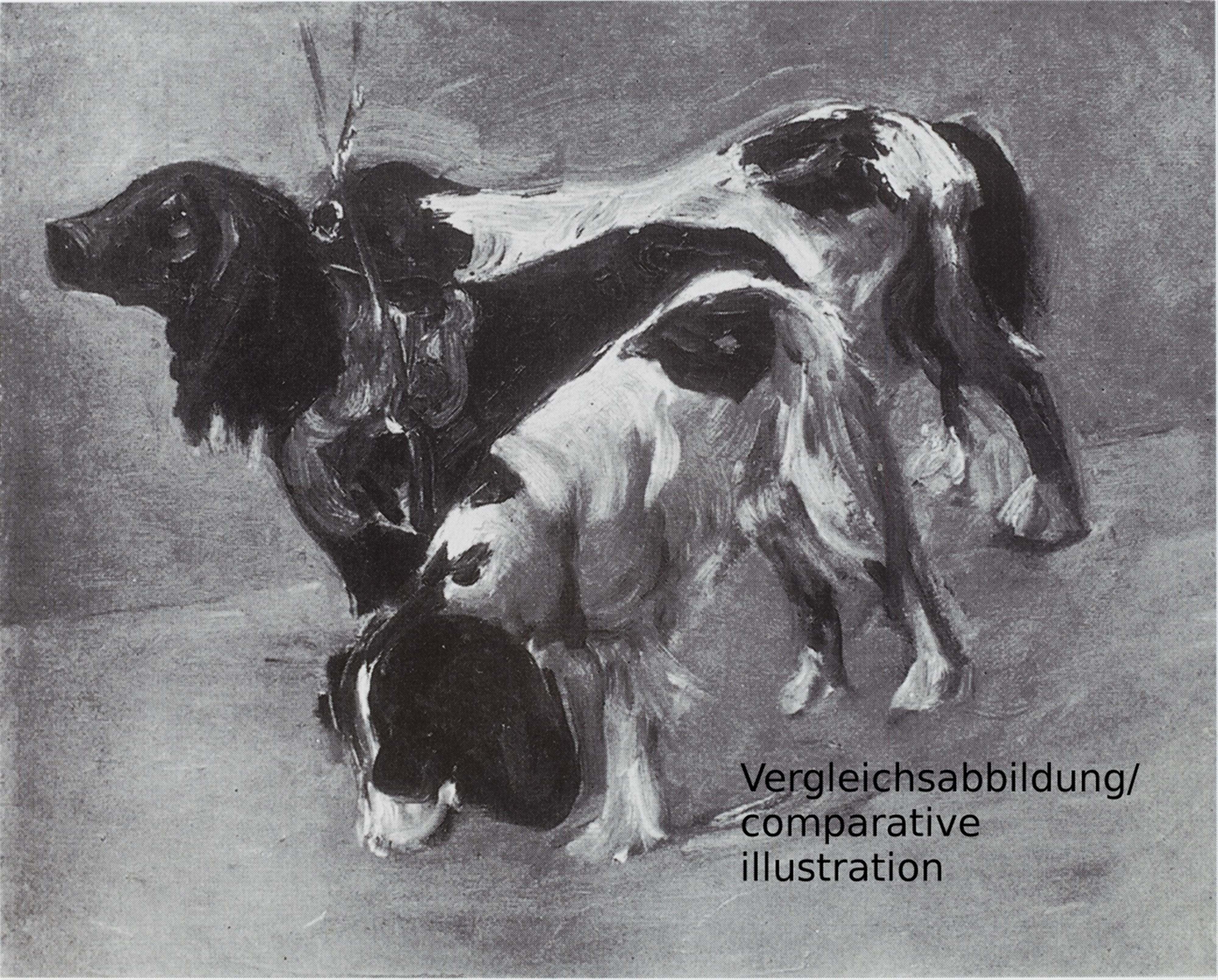Max Liebermann
Zwei Spaniels
1914
Oil on painter's board, mounted on panel (parquetted verso) 64.5 x 81 cm Framed. Signed and dated 'M. Liebermann 14' in brown upper right. - Two minimal losses of colour; upper edge of card with small gaps in places. Along the edges with nail holes and small, unobtrusive retouches .
This large-format painting presents a cropped view of two spotted cocker spaniels like those also found in the group of the painting “Jäger mit Hundekoppel” (Eberle 1913/31, whereabouts unknown), which is dated “1913”. A very similar isolated pair of dogs is also found in a painting - likewise dated “1913” - in the collection of Wolfgang Gurlitt (“Zwei Spaniels”; Eberle 1913/26, same dimensions, now in the Neue Galerie der Stadt Linz). The present work evidently belongs to a small series of a total of six dog portraits documented by Eberle, some of which must be considered lost works.
These depictions of animals can all be traced back to the artist's summertime stay in Nordwijk, where he could observe the rabbit hunt with spaniels in the dunes. Accompanied by Paul Cassirer - who owned a summer home in Nordwijk - and the journalist Harry David, the painter had come at the invitation of a Dutch tobacco magnate. The artist was shown the kennel, the animals were presented to him and he accompanied the hunting party with its swarming dogs to the coast of the North Sea: all of this found realisation in the well-known dune landscapes entitled “Jäger in den Dünen” (cf. Eberle 1913/33-1913/37).
The typical group behaviour of the animals, their intelligence and agility and not least the liveliness of the spaniels, with their beautiful fur, seem to have fascinated Liebermann. H. David reported on their stay in an article (“Liebermann als Tiermaler”, in: Vossische Zeitung no. 106, 27 Feb 1914), and in September of 1913 Liebermann himself commented in a text written to Alfred Lichtwark: “[...] we have been back for 3 days. My wife & Käthe from Switzerland, myself from Nordwyk, where my work was - I think - not without success: an English trainer with a pack of Spagniols, a breed of dogs like Velasquez painted them. And strangely enough, I had wanted to do something similar in Weimar over 40 years ago. Without being able to. If I can now?” (cited in Matthias Eberle, Max Liebermann, Werkverzeichnis, Munich 1996, p. 879)
If the deliberate cropping of the animals in this image is a modern and new means of expression in painting known from Impressionism, what is particularly impressive here is the manner of painting, which presents the art of Max Liebermann in the form of a sublime example. “Two large studies of brown-and-white and black-and-white spaniels are of consummate mastery in their representation of the long, silky fur” - was already observed at that time, in the review of the Berlin Secession exhibition of 1914, where the present painting was also exhibited (K. Zoege von Manteuffel, in: Kunst für Alle, op. cit., p. 468, cf. also illus. p. 465).
Catalogue Raisonné
Eberle 1913/27
Provenance
Münchner Sezession (1914; for sale); Private collection, Frankfurt a.M. (1927); Collection of Dr. A. Ganz, St. Niklas/Lucerne (until 1928); Cassirer-Helbing, Berlin (1928); Stuttgarter Kunstkabinett Ketterer (1955); Galerie Beyeler, Basel (1958); Hans Soraperra, Zurich (1958); Ketterer Munich (1969); Lempertz Cologne (1980, private possession, Switzerland); Collection Dr. Heinz Nickels, Bielefeld; Private possession, North Germany
Literature
Kurt Zoege von Manteuffel, Die Ausstellung der Freien Secession in Berlin, in: Kunst für Alle, vol. XXIX, no. 20, July 1914, p. 468; Karl Voll, Zu Max Liebermanns 70. Geburtstag, in: Kunst für Alle, vol. XXXII, no. 21/22, Aug. 1917, p. 401-408 with illus. p. 409; N.N., Versteigerung der Sammlung Ganz, in: Der Cicerone, vol. XX, 1928, no. 21, p. 714
Exhibitions
Berlin 1914 (1. Ausstellung der Freien Sezession), no. 137; Munich 1914 (Kunstausstellung der Münchner Sezession), no. 137; Frankfurt 1927 (Galerie Goldschmidt), Max Liebermann, Werke aus Frankfurter Privatbesitz, cat. no. 40 ("zwei Hunde, Öl auf Pappe, 65 x 78.5 cm, 1913"); Berlin 1928 (Cassirer-Helbing, 30 Oct. 1928), Collection Dr. A. Ganz, St. Niklas bei Luzern - Aus Berliner und anderem Privatbesitz - Aus dem Nachlass Paul M. Robinow Hamburg, no. 51 with Illus; Berlin 1936 (Jüdische Gemeinde), Max Liebermann, no. 38; Stuttgart 1955 (Stuttgarter Kunstkabinett), 21st auction 24-27 May 1955, lot 1609 (not listed among the results); Munich 1969 (Galerie Ketterer), 2nd auction, 20./21.5.1969, lot 833, illus. p. 191; Cologne 1980 (Kunsthaus Lempertz), 576th auction, Kunst des XX. Jahrhunderts, 17 Aug.1980, lot 409, pl. 31








